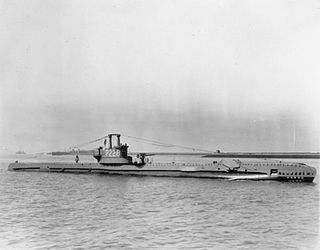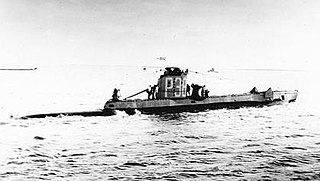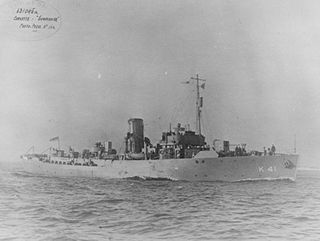
HMS Upholder (P37) was a Royal Navy U-class submarine built by Vickers-Armstrong at Barrow-in-Furness. She was laid down on 30 October 1939, launched on 8 July 1940 by Mrs. Doris Thompson, wife of a director of the builders. The submarine was commissioned on 31 October 1940. She was one of four U-class submarines which had two external torpedo tubes at the bows in addition to the 4 internal ones fitted to all boats. They were excluded from the others because they interfered with depth-keeping at periscope depth.

HMS Arbutus was a Flower-class corvette of the Royal Navy, which was active during the Second World War. She was a successful escort vessel, and took part in the destruction of two U-boats during the Battle of the Atlantic. Arbutus was torpedoed by a U-boat and sunk in the North Atlantic in February 1942 while aiding a convoy that was under attack.

HMS Safari was a third batch S-class submarine built for the Royal Navy during World War II. Commissioned in 1942, she was assigned to operate in the Mediterranean Sea. During the course of the war, Safari sank twenty-five ships, most of which were Italian.
HMS P33 was a Royal Navy U-class submarine built by Vickers-Armstrong at Barrow-in-Furness.

HMS P48 was a Royal Navy U-class submarine built by Vickers-Armstrong at Barrow-in-Furness. Commissioned on 18 June 1942, Vickers arranged for the wife of serving submarine Captain, Alister Mars of HMS Unbroken, Ting Mars and Commander of the cruiser Jamaica to officially launch P.48 at Barrow dockyard.

HMS Splendid was a third-batch S-class submarine built for the Royal Navy during World War II. She was laid down on 7 March 1941 and launched on 19 January 1942. After an initial patrol through the Bay of Biscay to Gibraltar, Splendid conducted two patrols in the Mediterranean Sea; one was abandoned after technical problems and on the other she sank two Italian ships. On her next patrol, the submarine attacked two Italian convoys, sinking an Italian destroyer in the second attack. Based in Algiers, the boat operated north of Sicily, sinking six Italian ships, including two tankers and two heavy merchant ships. Splendid was detected by a German destroyer on 21 April 1943 while patrolling off Naples, Italy; the submarine was attacked with depth charges by the destroyer and forced to surface, after which she was scuttled and her surviving crew members taken prisoner. She was the most successful British submarine by tonnage sunk between November 1942 and May 1943.

HMS Rorqual (N74) was a British mine-laying submarine, one of the six ships of the Grampus class of the Royal Navy. She was built by Vickers Armstrong, Barrow and launched 27 July 1936. She served in the Second World War in the Mediterranean and in the far east. She was the only Grampus-class submarine to survive the war, and she is considered the most successful minelaying submarine of World War II, sinking 57,704 GRT of enemy shipping, 35,951 of which through her mines.

HMS Turbulent (N98) was a T-class submarine of the Royal Navy. It was laid down by Vickers Armstrong, Barrow and launched in May 1941.
HMS Union was a British U class submarine, of the second group of that class, built by Vickers Armstrong, Barrow-in-Furness. She was laid down on 9 December 1939 and was commissioned on 22 February 1941.

HMS Utmost was a British U class submarine, of the second group of that class, built by Vickers Armstrong, Barrow-in-Furness. She was laid down on 2 November 1939 and was commissioned on 17 August 1940. So far she has been the only ship of the Royal Navy to bear the name Utmost.

HMS P38 was a Royal Navy U-class submarine built by Vickers-Armstrong at Barrow-in-Furness.

HMS P47 was a Royal Navy U-class submarine built by Vickers-Armstrong. She was transferred to the Royal Netherlands Navy before completion and renamed HNLMS Dolfijn.

Vice-Admiral Sir Arthur Richard Hezlet, nicknamed Baldy Hezlet, was a decorated Royal Navy submariner. He became the Royal Navy's youngest captain at the time – aged 36 – and its youngest admiral, aged 45. In retirement he became a military historian.
HMS Marigold was a Flower-class corvette of the Royal Navy. She was launched on 4 September 1940 and was sunk by an Italian air-dropped torpedo on 9 December 1942.

SM U-21 was a U-boat built for the Imperial German Navy shortly before World War I. The third of four Type U-19-class submarines, these were the first U-boats in German service to be equipped with diesel engines. U-21 was built between 1911 and October 1913 at the Kaiserliche Werft in Danzig. She was armed with four torpedo tubes and a single deck gun; a second gun was added during her career.

HMS Regent was a Rainbow-class submarine designed and built by Vickers Shipbuilding and Engineering in Barrow-in-Furness for the Royal Navy, and was launched on 11 June 1930. She was lost with all hands after striking a mine on 18 April 1943.

Captain Michael Lindsay Coulton "Tubby" Crawford DSC & Bar was an officer in the Royal Navy and submariner.

HMS Sunflower was a Flower-class corvette of the Royal Navy. She served during the Second World War.

HMS Periwinkle was a Flower-class corvette, built for the Royal Navy during the Second World War, and was in service in the Battle of the Atlantic. In 1942 she was transferred to the United States Navy as part of the Reverse Lend-Lease arrangement and renamed USS Restless, one of the Temptress-class gunboats. With the end of hostilities she was returned to the Royal Navy and sold into mercantile service.

Pegaso was a torpedo boat and an escort aviso of the Italian Regia Marina. She was one of the most successful Axis anti-submarine warships of World War II.
















